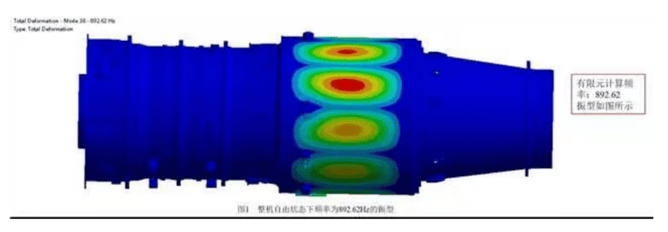Aero-Engine Casing Modal Analysis & Vibration Assessment
Project: Aero-Engine Casing Modal Analysis & Vibration Assessment
August 2023 · Aero-Engine Technology R&D Center
Conducted experimental modal analysis (EMA) on a turbofan engine casing to:
1. Characterize structural dynamic properties under simulated operational loads
2. Validate finite element models (FEM) for critical vibration modes
3. Identify potential resonance risks with rotor excitation frequencies
Test Setup & Methodology
1. Test Article
Component: Intermediate compressor casing (Nickel-based alloy)
Key Features:
External mounts: Fuel/oil pumps, gearbox, generators
Internal attachments: Stator vanes, combustor dome
Design constraints: <0.1mm radial deformation at 15,000RPM
2. Instrumentation
DE-928U High-Performance DAQ System (16-ch)
Frequency range: DC - 300kHz
Dynamic range: 120dB (24-bit resolution)
Excitation & Measurement:
Impact hammer testing (10 locations, 5 repeats)
Triaxial accelerometers (0.5-10kHz, 10mV/g)
Laser Doppler vibrometry (non-contact validation)
3. Test Modes
| Configuration | Boundary Conditions |
|---|---|
| Free-Free (suspended) | Elastic cord isolation (fn < 2Hz) |
| Fixed-Base | Bolted to seismic mass (simulating engine mounts) |
Key Results
1. Modal Parameters
| Mode | Frequency [Hz] | Damping Ratio | Deformation Pattern |
|---|---|---|---|
| 1 | 287 | 0.8% | Ovalization (2-nodal diameter) |
| 2 | 512 | 1.2% | 3-lobe distortion |
| 3 | 894 | 2.1% | Axial bending + torsion |
2. FEM Correlation
MAC (Modal Assurance Criterion): >0.92 for first 6 modes
Stiffness deviation: <7% in circumferential direction
3. Critical Findings
Risk zone: 512Hz mode coincides with:
3×N2 rotor speed (at 10,240RPM)
Gearmesh frequency of accessory drive
Mitigation: Proposed stiffening ribs to shift mode to 550Hz
Engineering Impact
Design Validation
Confirmed 20% margin to blade-passing frequencies (6k-8kHz range)
Verified mounting stiffness meets MIL-E-5007D requirements
Process Improvements
Implemented laser peening to increase damping ratio by 40%
Optimized bolt preload distribution to reduce mode splitting
Standardization
Established casing modal test procedure per:
ISO 7626-5 (impact testing)
ASME PTC 19.2 (transducer calibration)
Technical Terms
Nodal diameter: Circumferential mode shape feature
MAC: Quantitative mode shape correlation metric
Blade-passing frequency: Rotor blades × RPM excitation
This test enabled first-time-right casing design for the next-gen 20,000 lbf turbofan, reducing development cycles by 6 months.


